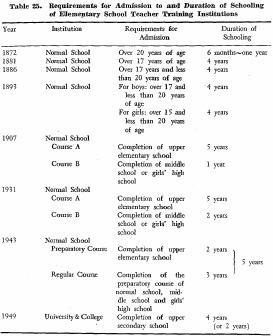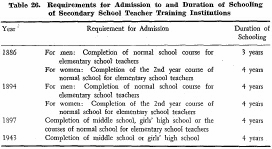| Home > Policy > White Paper, Notice, Announcement > White Paper > JAPAN'S GROWTH AND EDUCATION 1963 > CHAPTER |
||
Prior to the war, the normal schools were the institutions training elementary school teachers. In 1907 the normal school curriculum was extended from four years to five years, and in 1943 the schools were elevated to college status.
The number of class hours in normal school increased from 28 per week in 1881 to 34 per week in 1907 and 40 per week in 1943. As early as 1872, the government provided subsidies to defray the expenses of students attending normal schools, and to secure the excellent quality of students, and in 1879, normal school graduates were exempted from military service.
After the war, as a result of the over-all reformation of the educational system, the normal school system was discontinued and it was decided that teacher training Should be conducted in universities and colleges. Thus, the standard curriculum for training elementary school teachers has become three years longer than that of pre-war days.
The training of secondary school teachers was the responsibility
of the higher normal schools until after World War ![]() .
Their curriculum was fixed at four years soon after 1886, and remained at that
level until the reorganization of 1949. In 1897, requirement for admission to
higher normal schools came to include completion of middle schools and girls'
high schools as well as completion of normal schools.
.
Their curriculum was fixed at four years soon after 1886, and remained at that
level until the reorganization of 1949. In 1897, requirement for admission to
higher normal schools came to include completion of middle schools and girls'
high schools as well as completion of normal schools.


Certification and employment of secondary schools have not been limited to graduates of the higher normal schools. Graduates of colleges or universities could secure certificates, or certificates could be secured by examination. Since the war, professional teacher training has been provided in colleges and universities in a 4-year curriculum of higher education level.
Teacher training in other countries, except for elementary school teachers in France and the U.S.S.R., is provided in institutions for higher education. The general trend in teacher training in other countries is that the elementary school teachers arc trained in special teacher training institutions and secondary school teachers both in special teacher training institutions and in general higher educational institutions. There is only a slight difference in the length of the period of training in various countries.
The length of the teacher training program in Japan compares favorably with many countries, but the certificates are granted solely on the basis of completion of a fixed number of credits, without requirement of actual professional educational training.
In the United Kingdom, the German Federal Republic, France and the U.S.S.R., even graduates of the teacher training institutions are not granted a teacher's certificate without succeeding in the examination for the teacher's license and in the examination on teacher qualifications.
| Back to Top | MEXT HOME |